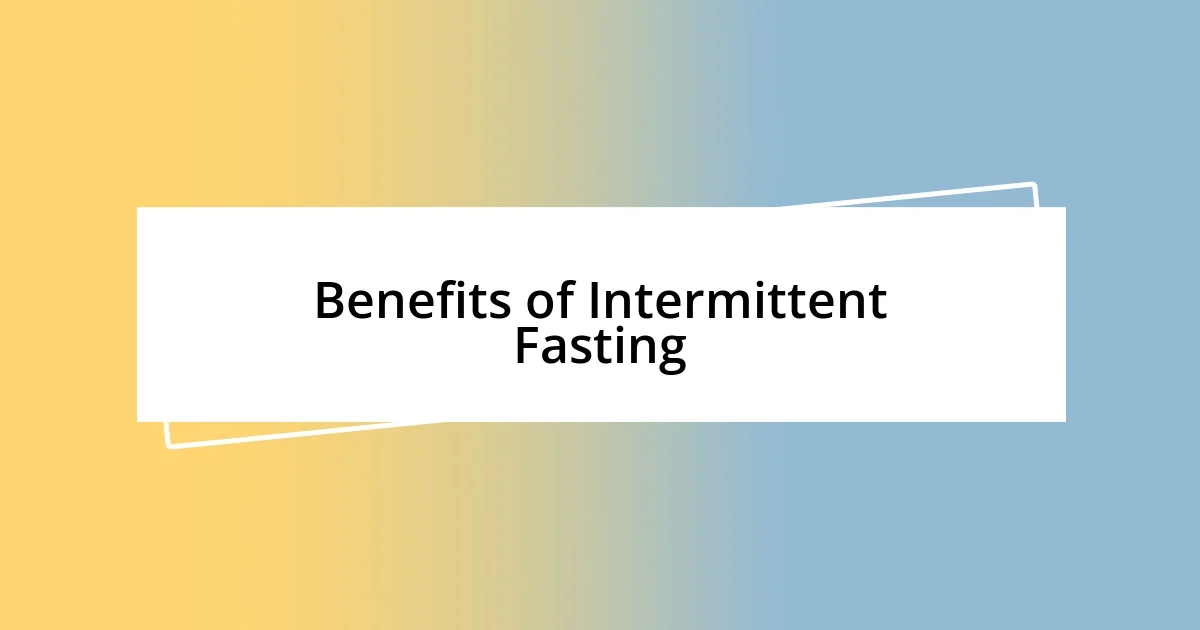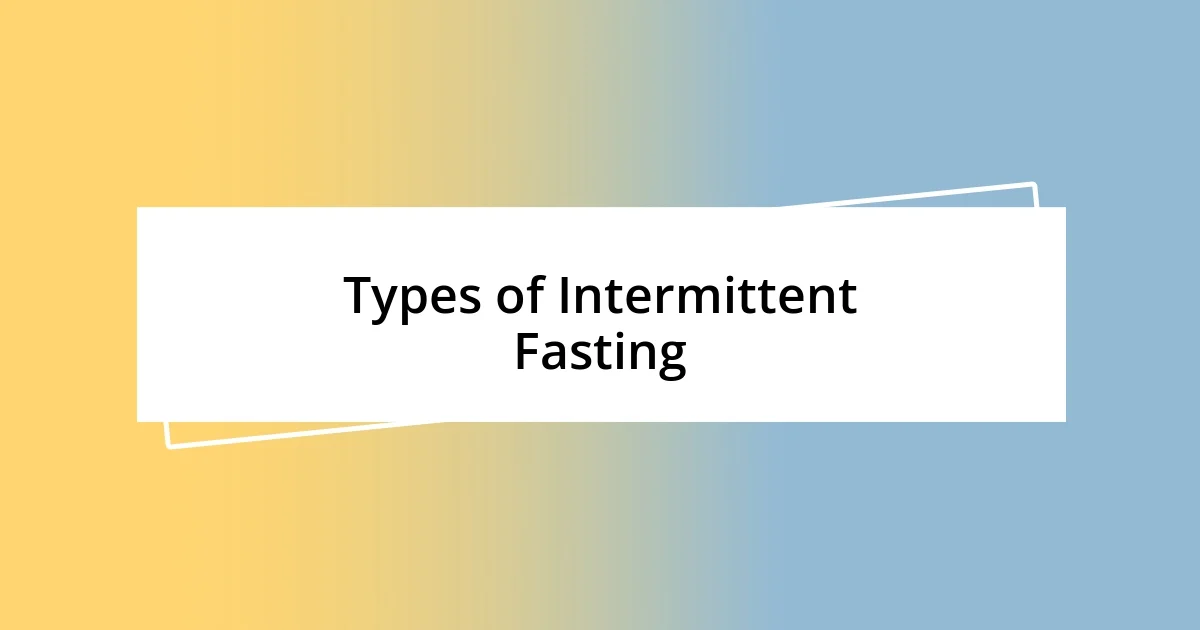Key takeaways:
- Intermittent fasting involves alternating between eating and fasting periods, leading to benefits like increased energy, improved mental clarity, and enhanced metabolic health.
- Different types of intermittent fasting (e.g., 16:8, 5:2, Eat-Stop-Eat) offer flexibility, allowing individuals to choose what best fits their lifestyle.
- Successful fasting requires proper planning, staying hydrated, and focusing on nutritious foods during eating windows to avoid common pitfalls and maintain motivation.

Understanding Intermittent Fasting
Intermittent fasting is more than just skipping meals; it’s a lifestyle choice that can have profound effects on both body and mind. When I first tried it, I felt a mix of curiosity and skepticism. Could a simple change in my eating pattern really bring about the health benefits everyone was talking about?
At its core, intermittent fasting involves alternating between periods of eating and fasting. I remember my first 16:8 fast—it felt challenging at first, but I was surprised by how clear-headed I felt after a few days. This clarity made me wonder, have you ever experienced a moment when your body and mind just clicked? That’s exactly what happened to me, and it sparked my interest in exploring further.
Many people find that this approach not only helps with weight management but also enhances metabolism and promotes cellular repair. I can’t tell you how invigorating it was to learn about autophagy—our body’s way of cleaning out damaged cells—during my fasting periods. It made me feel like I was part of something much bigger than myself, connecting my habits with a deeper understanding of health and longevity.

Benefits of Intermittent Fasting
Intermittent fasting offers a variety of benefits beyond just weight loss. One of the most surprising outcomes I experienced was an increase in energy levels. Initially, I thought skipping breakfast would leave me feeling sluggish, but instead, I felt more alert and focused. It’s fascinating how the body adjusts and utilizes energy more efficiently during fasting periods.
Another significant benefit I’ve seen is improved mental clarity. During my fasting hours, I often find myself tackling complex tasks with greater ease. I vividly recall one afternoon where I was working on a creative project; the ideas just flowed effortlessly. Have you ever noticed how distractions seem to fade when you’re focused on something meaningful? That’s exactly what intermittent fasting has done for my productivity.
Moreover, intermittent fasting can also enhance metabolic health. Research supports that it helps lower blood sugar levels and improves insulin sensitivity. I remember measuring my glucose levels during my fasting experiment and was surprised to find them well within a healthy range. This little insight made me feel empowered, reinforcing the idea that simple changes can lead to significant improvements in overall health.
| Benefit | Personal Experience |
|---|---|
| Increased Energy Levels | Felt more alert and focused after fasting. |
| Mental Clarity | Creative ideas flowed effortlessly during fasting. |
| Improved Metabolic Health | Blood sugar levels were well within a healthy range. |

Types of Intermittent Fasting
Intermittent fasting isn’t a one-size-fits-all approach; there are several types to explore. When I first discovered the variety, I realized this flexibility made the practice more appealing. For example, the 16:8 method, where you fast for 16 hours and eat during an 8-hour window, became my go-to. I remember the sense of accomplishment I felt when I nailed my first week on this schedule—my body adapted surprisingly well, and I was amazed at how much food I could still enjoy without feeling deprived.
Here are some popular types of intermittent fasting:
- 16:8 method: Fast for 16 hours, eat during an 8-hour window.
- 5:2 diet: Eat normally for five days, restrict calories (around 500-600) on two non-consecutive days.
- Eat-Stop-Eat: Involves fasting for a full 24 hours once or twice a week.
- Alternate-day fasting: Alternates between a day of normal eating and a day of fasting.
- Warrior Diet: Fast all day and eat a large meal at night, typically within a 4-hour window.
Experimenting with these methods made me feel empowered to find what worked best for my body. I remember shifting to alternate-day fasting and the thrill it brought; it was like uncovering a new layer of my personal health journey. Each method sparked a different reaction in my body, and those small victories kept me motivated.

How to Start Intermittent Fasting
Starting intermittent fasting can be an exciting yet daunting journey. I remember the first time I decided to try it; I chose the 16:8 method because it felt manageable. I simply skipped breakfast and waited until noon to eat. The initial hunger pangs were challenging, but soon I found myself adapting, and I even started to look forward to my meal times like they were mini-celebrations.
It’s essential to listen to your body as you begin your fasting journey. The first couple of days, I felt a bit irritable and unfocused, but I kept reminding myself that my body was in transition. Have you ever gone through a similar adjustment period? I found that staying hydrated with water or herbal teas helped curb hunger and lifted my spirits. Over time, those feelings of discomfort faded, and I discovered a newfound clarity and focus throughout my fasting hours.
Finding your rhythm is crucial, too. After a few weeks, I started experimenting with my eating window to see what felt best for me. My friends were amazed when I shared how I tweaked my schedule on weekends for more social flexibility. This discovery not only made it easier to enjoy dining out but also reinforced that intermittent fasting doesn’t have to be rigid—it can be a customizable, enjoyable part of my lifestyle. What’s your ideal routine going to look like? Embracing the process can transform it from a chore into a rewarding experience.

Tips for Successful Fasting
Staying hydrated is one of the simplest yet most effective tips I can share for successful intermittent fasting. I learned early on that sipping on water or herbal teas, especially during the fasting hours, kept my cravings at bay and made the process feel so much easier. I found myself enjoying warm cups of chamomile or peppermint, which not only helped curb my hunger but also transformed my fasting routine into a soothing ritual—kind of like treating myself, even while I was abstaining from food.
Another key tip is to plan your meals ahead of time. In the beginning, I struggled with what to eat during my eating windows. One Sunday, I dedicated a bit of time to meal prepping, and it was a game-changer. Having healthy, balanced meals ready to go made me feel more in control and less likely to indulge in unhealthy options when hunger struck. Have you ever felt overwhelmed by food choices? I certainly have, and preparing meals in advance alleviated that stress.
It’s also vital to be gentle with yourself during this journey. There were days when I stumbled or felt tempted to give up, and I realized that it’s perfectly normal to have ups and downs. On a particularly tough day, I allowed myself a small treat—just a square of dark chocolate—and it reminded me that balance is key. This approach not only helped maintain my motivation but also reinforced that intermittent fasting doesn’t have to equate to deprivation; it can be a responsible way to enjoy food without guilt. Have you experienced a moment like that, where a little indulgence made your journey easier?

Common Mistakes to Avoid
When it comes to intermittent fasting, one of the most common mistakes people make is diving into it without proper planning. I remember rushing into my first fasting experiment, thinking I could just wing it. The reality? My lack of a meal strategy left me scrambling during my eating windows, which often led to hasty, unhealthy food choices. Have you found yourself stuffing your face just to satisfy hunger quickly? It’s a trap that can derail your progress.
Another pitfall is underestimating the importance of hydration. At first, I treated hydration like an afterthought, and I quickly realized my energy levels were slipping. On days when I neglected my water intake, fatigue set in, affecting my focus and motivation. Reflecting on that experience, I now know that staying adequately hydrated is not just beneficial; it’s essential for a thriving fasting experience. How often do you pause to really consider your hydration habits throughout the day?
Lastly, one error that many believers of fasting can run into is the idea that they can eat whatever they want during their eating window. I initially thought, “It’s my time to indulge!” But this mindset led to consequences like bloating and lethargy. I learned that quality matters just as much as quantity. Incorporating nutrient-dense foods into my meals made me feel more energized and sustained. Have you experienced that shift in how you feel after focusing on wholesome foods? Adjusting my mindset truly transformed my fasting experience.

Tracking Your Progress with Fasting
Tracking your progress during intermittent fasting can be tremendously empowering. I remember the first time I used a simple notebook to jot down my fasting hours and how I felt each day. Seeing those entries, the ups along with the downs, helped me understand my body better. It also provided a sense of accomplishment, as I could visually track my consistency and adapt my approach based on my reflections.
Another method I found incredibly helpful was using a fasting app to monitor my progress. I initially hesitated, thinking it might feel too rigid, but those little notifications celebrating my streaks kept me motivated. They reminded me that I was part of a larger community of fasters, which made all the difference. Have you ever found that sense of community in your wellness journey? It’s inspiring, and it reinforces the commitment to stick with it.
Finally, I discovered that regular weigh-ins and measurements can provide concrete feedback, but I had to remind myself to be patient. In the beginning, I nearly obsessed over every small fluctuation, which only led to frustration. I learned the value of celebrating non-scale victories—like feeling more energetic or fitting into my favorite pair of jeans. Those moments of realization were often the most rewarding. How do you celebrate your successes along this journey? Acknowledging progress, whether big or small, is vital for staying motivated.














